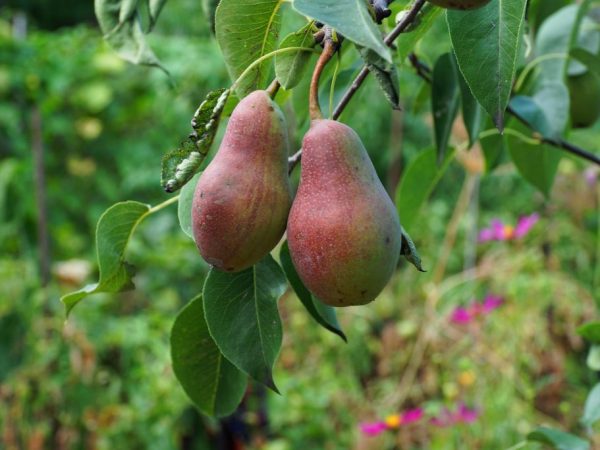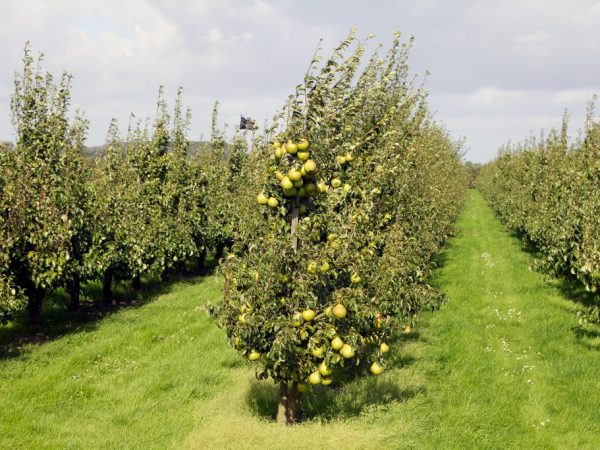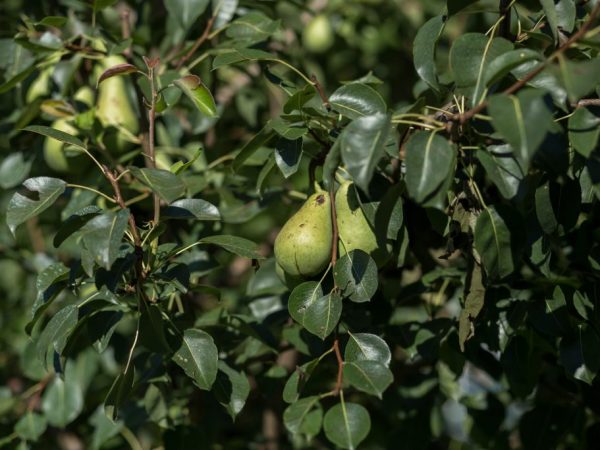Description of pear Talgar beauty
Pear Talgar beauty is one of the most widespread varieties in Russia. This species is characterized not only by the beauty of the fruit, but also by excellent yield indicators.

Description of pear Talgar beauty
Characteristics of the variety
Pear Talgar beauty was bred in Kazakhstan. The development was carried out by one of the leading specialists of the country - Katseiko. This variety was bred as a result of natural pollination of a crop such as Forest Beauty. Since 1960, this culture has been tested. Only in the early 90s, she was able to get a place in the State Register of the Russian Federation.
According to the description, the cultivation of this pear is carried out only in the regions of the North or in the Caucasus region. Despite this, most of the inhabitants of the southern and central regions grow it on their plots.
Description of the plant
The height of the tree is 3-4 m. The crown is pyramidal, of moderate density. The branches hang down evenly. On the surface of the main trunk and side branches there is a peeling gray bark. Fruit formations are located on the ringlet.
Shoots characteristic: they are of moderate thickness and smooth surface. The color of the bark on the shoots is brown. The conical shape of the buds does not have a large amount of edging. The color of the leaves is dark green, the surface of the leaf is smooth and the tip is pointed. Small denticles are located along the edges of the leaves.
The main pollinators of the culture are bees and related pear varieties. To increase the yield, shoots are planted at a distance of no more than 10 m from each other.
Only varieties that are resistant to diseases and low temperatures are chosen as pollinators.
Description of fruits
Pear variety Talgar beauty has medium-sized fruits (average weight - 170 g). Individual pears reach a weight of 250-300 g (with good care).
The following characteristics of the fruit should also be noted:
- oval shape;
- the upper part is slightly beveled;
- rich yellow color;
- the main part, starting from the end, is covered with a pale pink tint;
- the peel is glossy, smooth to the touch;
- on the surface of the peel, small dots of various shades (black, white or beige);
- the pulp is creamy, juicy, there are a small amount of seeds inside.
The taste is rich, sweet. According to the description, sugar is 15%. You can eat the crispy fruits of this tree fresh or prepare various desserts from them. Often, baby food is prepared from the fruits of this variety.
Landing rules

The variety grows in any region
Talgar beauty is a picky variety that can bear fruit in any part of the country. It is better to plant seedlings in regions with a warm climate.
Boarding time
The seedlings are planted in the fall. They choose a time so that there is no frost yet, otherwise the open root system will die under the influence of low temperatures.You need to wait until the leaves fall from the trees: they will cover the ground and warm it a little.
If the tree was not planted in the fall, you can start this procedure in the spring. It is better to do this in early April, when the foliage on the trees has not yet appeared, but the earth has warmed up to a temperature of 8-10 ° C.
Optimal location
Choose lighted areas on the south side. Constant sunlight will speed up the formation of buds and a slight blush on the fruit. You can also put a fence at a distance of 3-4 m from the plant. This allows you to protect it from constant winds and the formation of shadows.
Soil requirements
The Talgar beauty does not bear fruit in clay and boggy areas. Preference is given only to loose and nutritious soils. The acid-base balance should not exceed 4%. In the presence of groundwater, planting is possible only in elevated areas or using drainage in the holes.
Landing
In order for the Talgar beauty to quickly take root in a new place and give high yields, you need to follow the following rules:
- The hole is dug a few weeks before the intended planting. Sizes directly depend on the size of the root system. The average depth of the hole is 50 cm and the depth is 130 cm.
- Organic matter is added to the well. It is believed that the seedling will take root better in the soil if you add several buckets of humus or compost. Such substances help to increase the adhesion of roots and soil.
- A special support in the form of a peg is driven into the pit. This is necessary so that the plant can be tied up. Also, the support is designed for even growth of the trunk. Only pegs are chosen, the height of which is 150 cm, and the width is at least 5 cm.
- After the seedling is placed in the hole, the roots are distributed around the entire perimeter of the hole. Gradually cover the earth so that it covers the entire root system. The pre-root part (neck) should be located above the ground.
- The earth is tamped and watered with 1 bucket of warm water. For these purposes, a special sprayer is used so that the top layer of the earth is not washed away under pressure.
Care rules

The tree needs to be well looked after
In order for the Talgar beauty to give high yields, you need to adhere to certain care rules.
Watering
Watering is carried out with warm water, depending on climatic conditions. In high heat, the plant is watered 2 times a week. If the air temperature is in the range of 20-25 ° C, watering is carried out once a week. For 1 sq. m plantings use about 5 liters of water.
Pruning
Pruning is carried out immediately after planting a young seedling. The side branches are cut into ¼ part. Only the skeletal branches are trimmed, not the main trunk. A mature tree should be pruned every year in the spring. Only new branches are cut, creating a dense cover. Sore areas, which take up most of the nutrients, should not be ignored. They also get rid of them.
Fertilizer
In the fall, mineral nitrogen substances are introduced, allowing the plant to recover over the winter. In the spring, the Talgar beauty should be fed with organic substances in the form of humus or bird droppings. At least 2 kg of fertilizer is applied to each bush.
Diseases and pests
Talgar beauty has good immunity. Despite the fact that this culture is rarely exposed to pests and fungal infections, certain preventive measures must be taken. Gardeners use both specialized chemical substances and folk remedies to combat parasites.
For fungal infections, it is better to use a mixture of different drugs. In the presence of scab, each tree is treated with a mixture of 1% Bordeaux liquid and 4% copper-containing chlorine. For powdery mildew, only colloidal sulfur in the amount of 30 g per 10 liters of warm water helps. Spraying is carried out every 10 days until the complete destruction of the disease.
Often this variety suffers from fruit rot. Unfortunately, it is impossible to cure this disease - all the fruits will have to be removed from the tree, but preventive measures can be taken. When the first inflorescences begin to appear, the tree is treated with a 1% solution of Bordeaux liquid.
The main parasites to which Talgarka is exposed are the honeydew, pear mite or moth. You can save yourself from the honeydew with the help of calendula tincture, which is sprayed on the plant every 3 days. Ticks are easy to kill with red cayenne pepper tincture (processed once a week). You can get rid of the moth, thanks to the nightshade tincture (3 glasses of berries are bred in 10 liters of water and insisted for a day).
Conclusion
To get a good and high-quality harvest, you need to take care of your horticultural crop.


